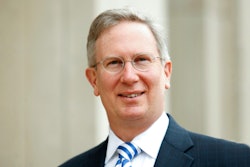Lessons in Inclusion
Dr. Wallace Loh didn’t quite fit in as a Chinese youth growing up in Peru, and he’s been committed to access and equity ever since
By Lydia Lum
Dr. Wallace Loh still remembers the sting of hearing his high school teachers in Peru call him “el chino” — Spanish for “Chinese boy.”
Why didn’t they simply use his name? After all, they did so with his
classmates. And, they typically didn’t single out students of other foreign nationalities, such as calling the German student “el alemán.”
“I had lived in Lima since age 2,” Loh recalls. “I spoke Spanish with no accent. But I keenly felt that I didn’t fit in.”
As an educator, Loh has shared that story with many students, especially at the University of Washington, where he was dean of law from 1990-1995. In that time, minority enrollment in UW’s law school doubled, reaching more than 40 percent. The boom in minority enrollment was at least partly because race was used as an admissions factor for the program.
But Loh, who’s now a dean at the private Seattle University, believes the practice of using race in the admissions process is slowly but surely dying. “The public has more reservations about race as a factor in scholarships, in hiring, in so many aspects of daily life compared to 20 years ago. They’re not racist. They just believe that race may not contribute to uniting this country.”
UW and other public universities in the state are now banned from considering race in admissions. Washington voters approved a measure that outlaws preferential treatment for women and minorities in public education, employment and contracting. In the 1997 Smith v. University of Washington Law School case, three White applicants sued the law school, claiming reverse-discrimination case because they were denied admission in the mid 1990’s. Last December, an appeals court ruled in favor of UW. But the law school has seen its minority enrollment dwindle down to 20 percent in recent years.
Michael Rosman of Washington, D.C.’s Center for Individual Rights, the plaintiffs’ lawyer in the reverse discrimination suit, criticizes the public for what he calls a lack of pressure on elected officials nationally to end race-conscious admissions and hiring. Meanwhile, plenty of opinion polls show growing opposition to those policies, Rosman says. “If people don’t speak up, we will continue having inertia among these universities.”
The case took its toll on Loh, who was a finalist for UW provost in 1997. Eventually, another finalist won the position. While Loh is matter-of-fact about the experience, he also recognizes the harsh scrutiny he received because of the lawsuit.
Changes Past and Present
Despite the setbacks, Loh remains committed to nudging as many underrepresented minorities as possible into higher education, never forgetting his own uphill climb. Born in Shanghai, Loh and his family moved from China to Peru in 1947 when his diplomat father was posted there on assignment. However, the family sought asylum in Peru once the Communists assumed power in China in 1949. Loh graduated from high school at age 15, but because Peruvian postsecondary studies were determined by one’s social connections, his family decided it was best for him to leave. He immigrated to the United States alone, speaking limited English, with about $200 in cash that his mother had sewn into the inside of his jacket. Loh went on to earn a doctorate in psychology from the University of Michigan and a law degree from Yale University. He has been a visiting professor at several American universities as well as at Beijing University.
After his tenure as UW law dean, he became vice chancellor of academic affairs and dean of faculties at the University of Colorado at Boulder. He went on to become director of then-Washington Gov. Gary Locke’s executive policy office.
Loh has served as arts and sciences dean since 1999, heading Seattle University’s largest academic division. He says to better reflect overall student enrollment in the school, which is about 50 percent White, he has doubled the number of female faculty and tripled the number of minority faculty. Under Loh’s tenure, Hispanic enrollment in arts and sciences has increased about 50 percent.
He continues believing that higher education institutions “can be excellent yet diverse. Neither goal has to be exclusionary but can be complementary.”
© Copyright 2005 by DiverseEducation.com


















